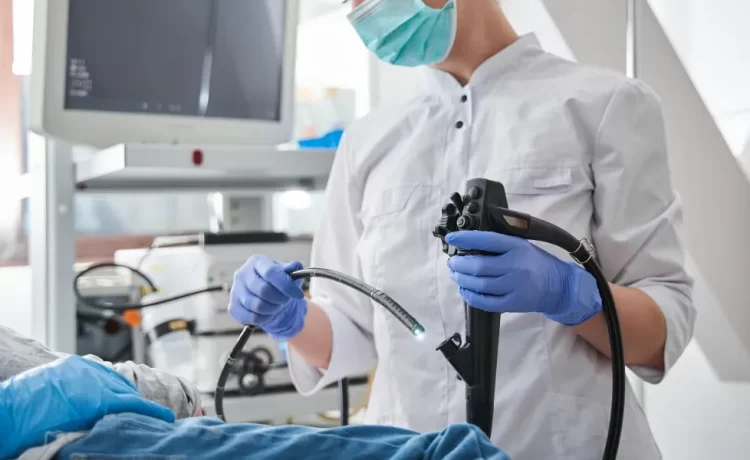Endoscopy has revolutionized modern medicine by allowing doctors to examine the inside of the body without making large incisions. This minimally invasive procedure involves inserting a flexible tube with a camera and light into the body to view internal organs and tissues in real-time.
It is commonly used to explore the gastrointestinal (GI) tract, but its application extends to other systems as well. By providing a clear view and enabling tissue sampling, the endoscopic procedure plays a crucial role in diagnosing a wide range of health conditions.
1. Gastroesophageal Reflux Disease (GERD)
GERD is a chronic digestive disorder in which stomach acid frequently flows back into the esophagus, causing heartburn and irritation. When symptoms are persistent or resistant to treatment, an upper endoscopy is often performed to assess damage to the esophageal lining. This helps confirm the diagnosis and rule out more serious complications such as Barrett’s esophagus.
2. Peptic Ulcers
Peptic ulcers are open sores that develop on the lining of the stomach or upper small intestine. They are often caused by Helicobacter pylori infection or long-term use of nonsteroidal anti-inflammatory drugs (NSAIDs). Through endoscopy, doctors can directly visualize the ulcers, determine their severity, and take biopsies if needed.
3. Celiac Disease
Celiac disease is an autoimmune condition triggered by the ingestion of gluten. It damages the small intestine’s lining, leading to poor nutrient absorption. While blood tests can indicate the possibility of celiac disease, endoscopy with a small bowel biopsy is essential for a definitive diagnosis. This allows doctors to examine the villi and confirm intestinal damage.
4. Esophageal Varices
Esophageal varices are enlarged veins in the esophagus that can rupture and bleed, particularly in people with liver disease. Endoscopy is the primary method for detecting and monitoring these veins. If active bleeding is found, doctors can use endoscopic techniques like banding or sclerotherapy to control it immediately.
5. Gastric Cancer
Gastric (stomach) cancer often develops silently in its early stages. Symptoms like weight loss, fatigue, or gastric discomfort may prompt a doctor to order an upper endoscopy. This allows for direct visualization of suspicious areas and biopsy collection. Early detection significantly improves treatment outcomes.
6. Inflammatory Bowel Disease (IBD)
IBD includes Crohn’s disease and ulcerative colitis, both of which cause chronic inflammation of the digestive tract. Colonoscopy, a type of endoscopy that examines the colon, is the gold standard for diagnosing and monitoring these conditions. It helps identify inflammation, ulcers, and complications such as strictures or fistulas.
7. Colon Polyps and Colorectal Cancer
Colonoscopy is the most effective tool for detecting colon polyps, which are growths on the inner lining of the colon that can turn cancerous over time. By identifying and removing these polyps during the same procedure, endoscopy not only diagnoses but also prevents colorectal cancer. Regular screening is recommended starting at age 45 or earlier for high-risk individuals.
8. Barrett’s Esophagus
Barrett’s esophagus is a condition in which the tissue lining the esophagus changes, often due to chronic acid reflux. This condition increases the risk of developing esophageal cancer. An upper endoscopy is necessary to diagnose Barrett’s esophagus, and tissue samples are taken for further examination. Surveillance through periodic endoscopy is often recommended for those diagnosed.
9. Upper GI Bleeding
Unexplained bleeding in the upper digestive tract can lead to symptoms like vomiting blood or passing black stools. Endoscopy is a critical diagnostic tool in identifying the source of bleeding, such as ulcers, varices, or tumors. It also allows for immediate therapeutic intervention to stop the bleeding.
10. Swallowing Disorders (Dysphagia)
Difficulty swallowing may result from structural abnormalities or motility disorders. Endoscopy helps identify causes such as esophageal strictures, rings, webs, or tumors. It provides a clear view of the esophagus and allows for dilation or other treatments if necessary.
The Diagnostic Power of Endoscopy
Endoscopy stands out as a powerful tool in modern diagnostics. It allows for a combination of visual inspection, biopsy collection, and therapeutic intervention, all in a single procedure. While it’s most commonly associated with gastrointestinal issues, its applications also extend to the respiratory system, urinary tract, and joints.
For patients, the benefits are clear: minimal recovery time, accurate diagnoses, and the potential to catch diseases early. Whether you’re dealing with persistent symptoms or undergoing routine screening, discussing the possibility of endoscopy with your healthcare provider can be a valuable step toward better health.















